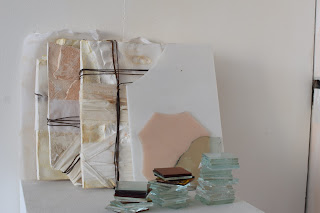Outpost 190822
LIGHTNESS
QUICKNESS
EXACTITUDE
VISIBILITY
MULTIPLICITY
Six Memos for The Next Millennium.
Italo Calvino, 1992.
The difference between the first versions I read and the final ones lies in structure, not content.
Calvino wanted to call the sixth lecture 'consistency' and he planned to write it in Cambridge.
I found the others, all in perfect order, in the Italian original, on his writing desk ready to be put into his suitcase.
Esther Calvino.
The Drought.
J.G. Ballard.
Allegories are, in the realm of thoughts what ruins are in the realm of things.
Walter Benjamin on the origin of German Tragic Drama.
Photographic ruins an amalgam/agency of what remains.
Brown and Blue.
A Field in England.
Cyanotype material on canvas with iron pigment.
Developing a spatial serenity/synthesis/synergy.
This amalgam of colour with various substances demonstrates the change and transformation of the material world, which can be interpreted as essentially an alchemistic procedure.
The goal of such procedures is ultimately to resolve the material object into its spiritual substance.
Yves Klein.
Beuys Brown and Klein Blue.
Magdalena Broska.
Air and Dreams.
An essay on the imagination of movement.
Gaston Bachelard.
Shotesham, site based inquiry,studio practice.
Spatial registers around the corporeal and the transcendental.
Ruin its relation to time.
Fragment as ruin and on melancholia as an attitude of retrospective contemplation.
Dialectics at a standstill, a moment where the past is recognized in the present as a ruin that was once desired, allowing allegory to be understood, felt as a contemplative calm, an equilibrium in the becoming and wrapping nowness of the self/situation.
Dialectical thinking involves the clarification of ideas through discussion and contradiction.
What remains after the process of dialectical thinking?
An initial thesis is opposed by an antithesis, then resolved through a synthesis of the two terms, which can in turn become a new thesis.
Objects/inclusions for painting with/layered transitions and movements.
Holga 120WPC, f135.
Ilford Delta 100/8 exposures 92x55mm.
The Gaze of Orpheus.
Maurice Blanchot.
The Essential Solitude
In the solitude of the work, we see a more essential solitude, a self communion.
MULTIPLICITY
The work grew denser and denser from the inside through its own organic vitality.
For Musil, knowledge is the awareness of the incompatibility of two opposite polarities. One of these he calls exactitude or at other times mathematics, pure spirit, or even the military mentality, while the other he calls soul, or irrationality, humanity, chaos.
Everything he knows or thinks he deposits in an encyclopedic book that he tries to keep in the form of a novel, but its structure continually changes; it comes to pieces in his hands.
The result is that not only does he never manage to finish the novel, but he never succeeds in deciding on its general outlines or how to contain the enormous mass of material within set limits.
The network that links all things is also Proust's theme, but in him this net is composed of points in space-time occupied in succession by everyone, which brings about an infinite multiplication of the dimensions of space and time.
The world expands until it can no longer be grasped, and knowledge, for Proust, is attained by suffering this intangibility. In this sense a typical experience of knowledge is the jealousy felt by the narrator for Albertine.
It is the extension of that being to all the points in space and time that it has occupied and will occupy.
But we cannot touch all these points. If only they were indicated to us, we might perhaps contrive to reach out to them. But we grope for them without finding them. Hence mistrust, jealousy, persecutions. We waste precious time on absurd clues and pass by the truth without suspecting it.
Remembrance of Things Past : The Captive.
Infra-ordinary.
Species of Spaces
We sleep through our lives in a dreamless sleep.
But where is our life?
Where is our body?
Where is our space?
Georges Perec.
CHORA : trace/mark/map/body
The drama of encountering space.
Recombinant Poetics via Interventions.
Thinking about temporal issues through visual, material and spatial registers.
Concerned with artworks and architectural projects that reconfigure the temporality of sites, repositioning the relationship of the past and the present in a number of different ways.
Allegory, Montage, Dialectical Image.
Between Art and Architecture.
Jane Rendell.
Performativity/Drama of Residency
Transient readings and encounters.
Other Enactments,Dialogues,Relationalities.
Sites of evidence/knowledge and understanding.
The scheme should incorporate both careful repair of existing fabric and a significant element of new construction in a contemporary design.
SPAB, design competition.
We are not calling for a new disordered architecture to match the disorder of culture; this would only affirm the chaotic.
Rather, we propose experiments in search of new orders, projections of new relationships.
We do not wish to transpose our study into a system or method.
The energy inherent in opening up relationships presents us with a continuity of ordering that compels refection.
Steven Holl.
Correlational Programming, Parallax.
.jpg)


.jpg)

